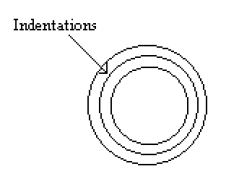A CD is made by having information burnt into the Polymer material using a laser. The indentations appear as fine circular tracks in the CD.
Data is written on the CD in a continuous spiral running from the center of the CD to its outside rim. All the bits in a file are written one after the other from beginning to end, then the next file is written, and so on.
A logical format (or file system) structures the raw bits on the CD in a virtual tree of directories and files, which makes it easier for both humans and computers to use the information.
ISO 9660 is a worldwide standard specifying the logical format for files and directories on a CD-ROM.

To use the CD-ROM discs, a CD-ROM drive is needed.
The devices in a CD-ROM drive are only able to read back pre-recorded sound or data by using a laser and detecting the pattern of light reflected from its beam.
The current CD-ROM drives use Multi-session & Multi-speed technologies due to the intense requirements of most multimedia applications. The Multi-session technology allows data to be written to a CD again & again until it reaches its maximum capacity (650MB).
The Multi-speed technology increases the rotational speed of the disk, thus increasing the data transfer rate of a CD-ROM drive.
Kavungya answered the question on
April 2, 2019 at 07:21